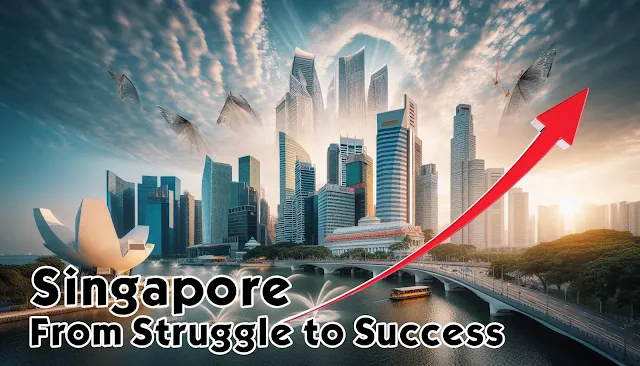Imagine a country plagued by widespread poverty, unemployment, high crime rates, drug-related problems, frequent riots, overpopulation, and illiteracy. Can you imagine the dire condition of such a country? You don’t need to imagine for too long because this was the reality of Singapore in 1965, but over the next 25 years, Singapore underwent a remarkable transformation, leaving the world shell-shocked.
Singapore became a highly developed, high-income country, and is considered among the top 3 richest countries in the world today (According to Worldatlas). One of the cleanest countries globally, with minimal corruption or other crimes, Singapore is perhaps the No. 1 Asian country in the truest sense. But how was this possible? Who is the hero of our story? In this video, let’s dive deep into the magical story of Singapore.
Singapore's Humble Beginnings
Singapore is a tiny country, friends. It's so small that it’s difficult to spot on a map. On the map of Southeast Asia, you can clearly see Indonesia, the Philippines, and Malaysia. But when you travel south, you’ll see the small island of Singapore, separated from Malaysia by the Strait of Johor. With an area of only 710 km² and a population of about 5.7 million, Singapore has a population density of 8028 people per square kilometer, making it the third most densely populated country, after Monaco and Macau.
Interestingly, the name Singapore originates from the Sanskrit word Singh Pura, meaning “The Lion City.” It is also one of the four Asian tigers, along with South Korea, Hong Kong, and Taiwan. Despite its high population density, Singapore’s GDP per capita is significantly higher than that of many countries.
Diverse and Harmonious Society
Singapore is a diverse country, with people from various religions and ethnicities living harmoniously. The largest ethnic group is Chinese, making up 74.5% of the population, followed by Malays at 13.5% and Indians at 9%. The remaining population includes Eurasians, Arabs, and the original inhabitants, the Orang Laut. This diversity wasn’t always peaceful, but today, ‘Unity in Diversity’ is Singapore’s reality.
Historical Struggles
Throughout its history, Singapore was a trading island occupied by various powers, including the Indonesian ruler, Portuguese, Dutch, and British. In 1819, Sir Thomas Stamford Raffles of the British East India Company bought Singapore from the Sultan of Johor, turning it into a free port. This gave rise to free trade and economic activity, but it also had a dark side. The British grew and processed opium in Singapore, leading to widespread addiction and crime.
During World War II, the Japanese occupied Singapore, bringing destruction, poverty, and suffering. After the war, the British regained control and attempted to restore basic services. By 1959, the young leader Lee Kuan Yew, Secretary-General of the People’s Action Party (PAP), became the first Prime Minister of Singapore.
The Turning Point
Initially, Lee Kuan Yew believed that Singapore couldn’t survive independently and sought to merge with Malaysia. However, due to political and racial tensions, Singapore was expelled from Malaysia in 1965, becoming an independent republic. This marked the beginning of a miraculous transformation, with Lee Kuan Yew at the helm.
Key Strategies for Development
1. Geopolitical Stability and Defense
- Lee Kuan Yew established ASEAN in 1967 to foster regional cooperation.
- Introduced National Service to build a strong defense force.
2. Focus on Education
- Singapore ensured compulsory primary education and high-quality public education.
- Emphasized vocational training to equip citizens with practical skills.
3. Ethnic Integration
- Implemented the Ethnic Integration Policy to promote communal harmony.
- Established the Maintenance of Religious Harmony Act and Racial Harmony Day to foster unity.
4. Cleanliness and Urban Planning
- Launched the Keep Singapore Clean Campaign.
- Relocated slum dwellers to public housing and provided essential services.
- Focused on urban beautification and environmental sustainability.
5. Efficient Healthcare and Transportation
- Provided affordable public and private healthcare.
- Developed a robust public transportation system to discourage car ownership.
6. Economic Growth
- Encouraged foreign investment and built world-class infrastructure.
- Established government-owned companies like Temasek Holdings to generate revenue.
- Maintained fiscal discipline and a high savings rate through the Central Provident Fund.
7. Eliminating Corruption
- Raised salaries of government employees and ministers to reduce corruption.
- Introduced strict anti-corruption laws and punishments.
The miraculous transformation of Singapore from a struggling nation to a global powerhouse is a testament to visionary leadership, strategic planning, and the collective effort of its people. Under the guidance of Lee Kuan Yew, Singapore embraced diversity, focused on education, maintained strict discipline, and prioritized cleanliness and urban development. These efforts turned Singapore into a shining example of what can be achieved with determination and unity. Thank you for joining us on this journey through Singapore’s incredible story.





